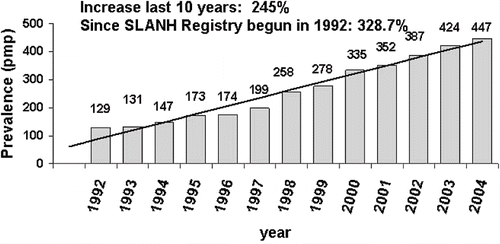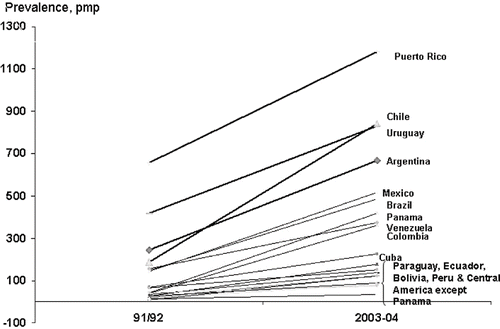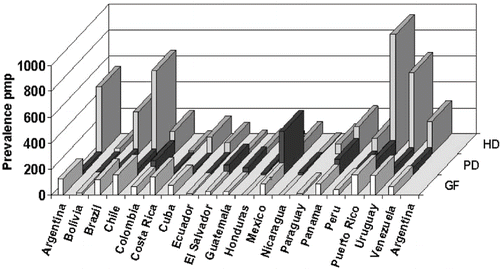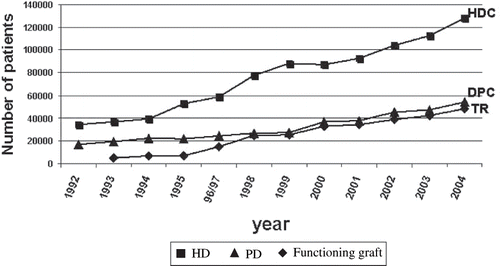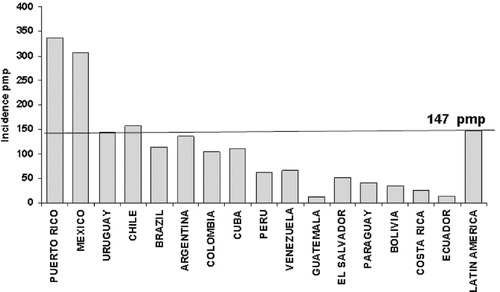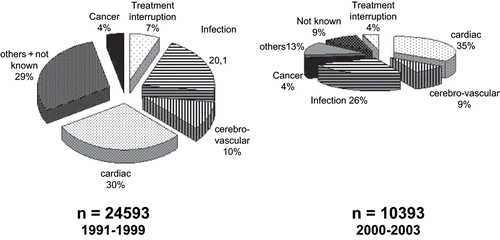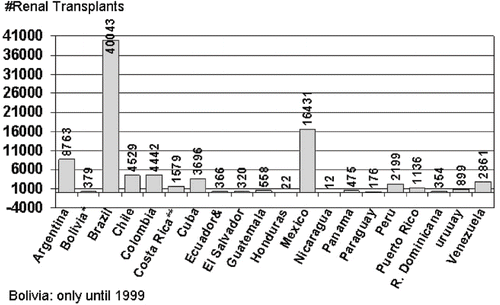Abstract
The Latin American Society of Nephrology and Arterial Hypertension's Dialysis and Transplant Registry was chartered in 1991. It collects information on ESRD and its treatment in 20 countries of the region. The prevalence of patients on renal replacement therapy (RRT) increased from 129 pmp in 1992 to 447 pmp in 2004; in 2004, 56% of the patients were on hemodialysis, 23% on peritoneal dialysis, and 21% had a functioning kidney graft. The highest rates of prevalence were reported in Puerto Rico (1027 pmp), Chile (686 pmp), and Uruguay (683 pmp). Hemodialysis was widely used, except in El Salvador, Mexico, Guatemala, Nicaragua, and the Dominican Republic, where peritoneal dialysis predominated. Incidence rate increased from 27.8 pmp to 147 pmp in the same period of observation; the lowest rate was reported in Guatemala (11.4 pmp) and the highest in Puerto Rico (337.4 pmp). Diabetes mellitus was the leading cause of renal failure in incident patients; the highest rates were reported in Puerto Rico (62.2%) and Mexico (60%). Forty-four percent of the incident population were older than 65 years. Access to renal replacement therapy was universal in Argentina, Brazil, Chile, Cuba, Puerto Rico, Uruguay, and Venezuela, while was restricted in other countries. Main causes of death in dialysis were cardiovascular (44%) and infectious disease (26%). The rate of renal transplantation increased from 3.7 pmp in 1987 to 14.5 in 2004; fifty-three percent of the organs came from cadavers. Overall, donation rate was 5.9 pmp. In conclusion, the prevalence and incidence rates have increased over the years, and diabetes mellitus has emerged as the leading cause of kidney disease in the region. Although the rate of kidney transplantation has increased, the number remains insufficient to match the growing demand. The implementation of renal health programs in the region is urgently needed.
BACKGROUND
Latin America is a group of nations that share a common Latin ancestry and the Spanish and Portuguese language. It includes Mexico, all countries from Central and South America, and the Hispanic Caribbean Islands. Its population, largely Caucasian, is estimated at 539,041,000 inhabitants, with an annual growth of 1.4%. Six percent of the population is older than 65 years.Footnote[1] Annual income per capita has remained stable the last four years, being between USD $650.00 and $3,300.00.Citation[2]
The Latin American Society of Nephrology and Arterial Hypertension (SLANH) includes 20 national affiliates (Argentina, Bolivia, Brazil, Chile, Colombia, Costa Rica, Cuba, Ecuador, El Salvador, Guatemala, Honduras, Mexico, Nicaragua, Panama, Paraguay, Peru, Puerto Rico, Dominican Republic, Uruguay, and Venezuela), with an estimated population of 534,144,893 inhabitants. These countries show extreme social and economic variations. In 2004, the average income per capita was USD $3,600.00, ranging from USD $960.00 in Bolivia to $10,560 in Puerto Rico.Citation[2] Life expectancy for the region was 70.9 years, varying from 64 in Bolivia to 79 years in Costa Rica. Similarly, the region,s average human development index was 0.777, and it varied from 0.649 in Guatemala to 0.853 in Argentina.Citation[3]
The registry has several limitations. First, most national registries are voluntary: not all affiliates report every year, and some report only consolidated data. Second, some countries, like Mexico, report national estimates based on regional registries. Finally, the number of patients with a functioning graft is largely unknown, and the data reported are largely estimates.
Nevertheless, even with these limitations, the registry has been a valuable source of information in regard to the epidemiology of end-stage renal disease and its treatment in Latin America. Additionally, it has stimulated the development of renal registries in the region and has allowed comparisons within the region and with renal registries elsewhere. The improvement of the quality of the data collected as well as the continuing participation of the country members has been the main goal of the registry.
METHODS
The SLANH Dialysis and Transplant Registry was chartered in 1991. Since then, it has released ten reports.Citation[4–14] Data are provided by a delegate designated by the national affiliate or directly by the registry's Coordinating Committee, completing questionnaires such as the nation's socio-demographic information, incident and prevalent patients on dialysis, and number and type of kidney transplants. Transplant data are collected and shared in association with the Latin American and Caribbean Society of Transplantation. Annually, this information is reported and stored in the Registry's database. This study reports data from the year 2004, except for dialysis in Ecuador (2003) and Costa Rica (2002), and renal transplantation in Bolivia (1999).
RESULTS
Prevalence
By December 31st, 2004, there were 230,901 patients on renal replacement therapy (RRT), for a prevalence of 447.2 pmp (see ). In all, 128,264 (56%) patients were on hemodialysis (HD), 54,181 (23%) on peritoneal dialysis (PD), and 48,456 (21%) had a functioning graft (FG). This distribution has remained mostly unchanged for the last four years. There has been a consistent growth in the number of patients on RRT. The expected prevalence for the year 2005 of 430 patients pmp was surpassed in the year 2004. The increased prevalence has been similarly observed in all countries (see ).
Based on data reported by 18 countries, the prevalence of patients on dialysis was 350.2 pmp. HD continues to be the treatment of choice in the region, representing 70% of the patients on dialysis, except in El Salvador, Mexico, Guatemala, Nicaragua, and the Dominican Republic, where PD represents 71%, 78%, 56%, 70%, and 80%, respectively, of the dialysis population (see ). PD is also common in Bolivia (34%), Honduras (36.7%), and Colombia (36.7%), although the percentage of Colombian PD patients has been consistently decreasing over the years (54% in 2000, 46.1% in 2001, 43.5% in 2002, and 40% in 2003). The highest dialysis prevalence (pmp) was reported in Puerto Rico (1026.7), Chile (686.3), and Uruguay (683); Argentina, Brazil, Mexico, Panama, and Venezuela reported prevalence rates between 300 pmp and 600 pmp. The lowest prevalence (<100 pmp) was reported in Bolivia, Costa Rica, Guatemala, Honduras, Nicaragua, Paraguay, and the Dominican Republic (see and ). Although the increment of patients was observed in all treatment modalities, HD growth was proportionally higher than PD and renal transplantation (see ). There was a lineal correlation between the gross national income per capita and the prevalence rate among the different countries of the region (see ). Diabetes was the main cause of ESRD in Puerto Rico (55.2%), Mexico (40%) Bolivia (36%), Chile (33%), Colombia (30%), Argentina (22%), and Guatemala (20.7%).
Table 1 Prevalence rates of patients on hemodialysis, peritoneal dialysis, with a functioning graft
Incidence
Acceptance rates have consistently increased over the years: it was 27.8 pmp in 1992, 94 pmp in 2002, and 147 pmp in 2004. Incidence rates varied widely across the region; the highest rates were reported in Puerto Rico (337.4 pmp), Mexico (305 pmp), Chile (157.8), and Uruguay (143.1 pmp); the lowest incident rates were seen in Bolivia (34.2 pmp), Ecuador (14.4 mpp), and Guatemala (11.4 pmp) (see ). Diabetes was the main cause of renal failure in Puerto Rico (62.2%) and Mexico (60%), followed by Venezuela (38%) and Colombia (32.9%). Additionally, the incident population on dialysis is aging; forty-four percent are >65 years and 21.4% are >75 years.
Mortality
Cardiovascular disease remains the main cause of death on dialysis (44%), followed by infection (26%); there was no significant variation in the distribution in the causes of death between the period 1991–1999 and 2000–2003, as shown in .
Hemodialysis Centers
There were 1892 dialysis units—one per 282,318 inhabitants, or one per 67 patients on HD. Dialyzer reuse is widely practiced in Argentina, Brazil, Chile, Cuba, Paraguay, Peru, and Uruguay, while is nonexistent in Costa Rica, Colombia, Guatemala, and Venezuela. It is practiced to a lesser scale in Mexico, Ecuador, and Puerto Rico.
Renal Transplantation
The first transplant was done in Argentina in 1957, followed by Mexico (1963), Brazil (1964), Colombia (1965), Chile (1966), Venezuela (1967), Costa Rica (1969), and Ecuador (1974). Currently, it is a well-established procedure among the 20 national affiliates of SLANH. There are 397 transplant centers registered—one per 1.3 million inhabitants, or one per 459 dialysis patients.
Transplantation has increased from 3.7 pmp in 1987 to 14.5 pmp in 2003 (see ). The number of transplants reported in 2004 was 7,588, nearly half of them reported from Brazil (see ) for a total of 89,129 transplants registered since 1957. The highest rates (pmp) were reported by Uruguay (29.7), Panama (25.2), Puerto Rico (22.1), Costa Rica (20), Argentina (19.6), Chile (16.8), Cuba (16.3), Brazil (18.6), and Mexico (16.8), while the lowest rates were observed in Guatemala (5.9), the Dominican Republic (2.8), Peru (2.4), Paraguay (1.1), and Honduras (0.4). For the first time, more than half (52.6%) of the grafts came from cadaver donors.
Organ donation rate for the region was 5.9 pmp. However, these rates are insufficient to match the growing demand. In only nine countries (Argentina, Brazil, Chile, Colombia, Cuba, Mexico, Puerto Rico, Uruguay, and Venezuela) is the transplant waiting list close to 42,000 patients.
Access to RRT
Access to RRT varies widely among the countries of the region. It is universal in Argentina, Brazil, Cuba, Puerto Rico, Uruguay, and Venezuela. Some of the population in Mexico (45%), Colombia (56%), Peru (30%) and Paraguay (25%) have their treatment covered by social security. In Bolivia, theoretically 63% of the patients have insurance for their treatment. However, 55.6% of the HD population receive only two dialysis treatments/week and 6.7% have only one session/week. For those on PD, 15.4% receive intermittent PD every 3–5 days, 42.3% every 6–10 days, and 29% every 15 days.
These data indicate that the number of programs is insufficient to cover the growing demand of dialysis and transplantation. Furthermore, in many Latin American countries, a public policy for the treatment of this disease is lacking, and dialysis for all will be unaffordable in the near future.
DISCUSSION
The high incidence and prevalence reported in some countries like Mexico and Puerto Rico, as well as the growing rates reported in those countries with universal access to RRT, make it highly unlikely that the lower prevalence of renal failure reported in the region is due to a lower prevalence of chronic kidney disease in this part of the world. Most likely it is due to other factors, such as an inaccurate registry of patients on dialysis and different approaches to detect and treat ESRD among the health systems of the region.
These data indicate that the number of programs is insufficient to cover the growing demand of dialysis and transplantation. Access to RRT is unequal between and within countries. It is worrisome that in the majority of Latin American nations, a public policy for the treatment of this disease is lacking, and dialysis for all will be unaffordable in the near future. In addition, it is expected that with the rise in the prevalence of non-communicable disease, such as obesity, diabetes mellitus, and hypertension, the incidence of ESRD will continue to increase. As it is unlikely that these countries will be able to afford the expense of maintaining a large population on dialysis like in the developed world, it is only through prevention and an integrated approach of affordable dialysis and transplantation that this catastrophic illness will be managed.
CONCLUSIONS
The prevalence of RRT continues to increase at a higher rate than the population growth in the region, and it is unlikely that the rate will reach a plateau in the near future. Diabetes has become the leading cause of renal disease, especially in countries like Puerto Rico and Mexico. Incident patients are becoming older and carry more comorbidity. More than 44% of patients are >65 years. Cardiovascular disease remains the main cause of death on dialysis, followed by infection. Renal transplantation and donation rates, although increasing, are insufficient to match the growing number of patients on dialysis. As in other developing nations, access to RRT is unequal. Public policy for the early detection, prevention of progression, and affordable treatment of kidney disease is urgently needed in Latin America.
Notes
1. Demographic Bulletin. Latin America: population by calendar years and single ages/year XXXVI, N° 71, January 2003. Economic Commission for Latin America and the Caribbean, Latin American and Caribbean Demographic Centre (CELADE), Population Division
REFERENCES
- http://devdata.worldbank.org/data, World Bank database. World development indicators, 2005
- http://hdr.undp.org/reports/global/2004/, United Nations Development Programme (UNDP). Human Development Report, 2004
- Mazzuchi N, Fernandez J, Schwedt E, et al. Registro Latinoamericano de Diálisis y Trasplante Renal. Año 1991. Nefrología Latinoamericana 1994; 1: 89–99
- Mazzuchi N, Scwedt E, Fernandez Cean J, et al. Registro Latinoamericano de Diálisis y Trasplante Renal. Año 1992. Parte I, Diálisis. Nefrología Latinoamericana 1995; 2: 309–331
- Registro Latinoamericano de Diálisis y Trasplante Renal. Año 1992. Parte II: Trasplante Renal. Nefrología Latinoamericana 1996; 3: 41–56
- Mazzuchi N, Scwedt E, Fernandez Cean J, et al. Registro Latinoamericano de Diálisis y Trasplante Renal. Informe 1993. Nefrología Latinoamericana 1996; 3: 320–357
- Mazzuchi N, Gonzalez F, Fernandez Cean J, et al. Registro Latinoamericano de Diálisis y Trasplante Renal. Informe de Diálisis 1994. Nefrología Latinoamericana 1997; 4: 136–200
- Mazzuchi N, Scwedt E, Fernandez Cean J, et al. Registro Latinoamericano de Diálisis y Trasplante renal. Informe año 1998. Nefrología Latinoamericana 1998; 5: 105–159
- Mazzuchi N, Scwedt E, Fernandez Cean J, et al. Registro Latinoamericano de Diálisis y Trasplante Renal. Informe 1999. Nefrología Latinoamericana 1999; 6: 151–205
- Mazzuchi N, Scwedt E, Fernandez Cean J, et al. Registro Latinoamericano de Diálisis y Trasplante Renal. Informe del año 2000. Nefrología Latinoamericana 2000; 7: 159–218
- Mazzuchi N, Scwedt E, Fernandez Cean J, et al. Registro Latinoamericano de Diálisis y Trasplante. Informe del año 2001. Nefrologia Latinoamericana 2002; 9: 190–243
- http://slanh.org/Registro, Mazzuchi N, Scwedt E, Fernandez Cean J, et al. Registro Latinoamericano de Diálisis y Trasplante. Informe del año 2002
- Cusumano A, Di Gioia C, Hermida O, et al. The Latin American Dialysis and Renal Transplantation Registry Annual Report 2002. Kidney Int 2005; 68(Suppl. 97)S1–S7, [CSA]
